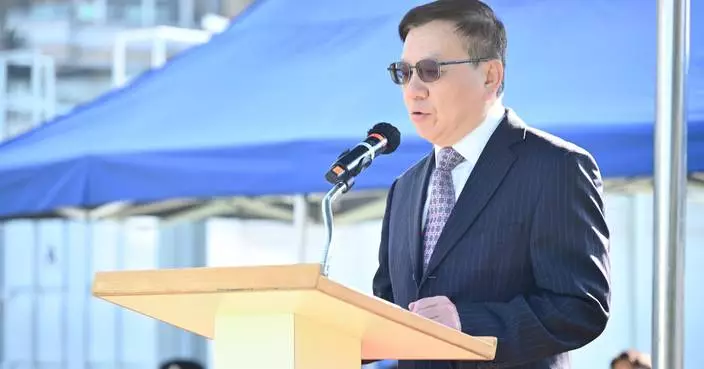A wet and unseasonably hot September
Mainly attributing to weaker than normal northeast monsoon over southern China, September 2024 was much hotter than usual in Hong Kong. The mean temperature of 29.2 degrees, mean maximum temperature of 32.0 degrees and mean minimum temperature of 26.8 degrees were 1.3 degrees, 1.5 degrees and 0.7 degrees above the respective normals and were respectively the third, one of the fourth and one of the seventh highest for September on record. With stronger than normal troughing flow in the lower atmosphere over the coast of southern China and the northern part of the South China Sea, the month was also cloudier and wetter than usual. The mean amount of cloud in the month was 74 per cent, 8 per cent above the normal of 66 per cent and one of the ninth highest on record for September. The monthly total rainfall was 520.9 millimetres, about 62 per cent above the normal figure of 321.4 millimetres. The accumulated rainfall this year up to September was 2104.3 millimetres, about 6 per cent lower than the normal figure of 2242.8 millimetres for the same period.
Under the influence of an anticyclone aloft, the weather of Hong Kong was very hot with sunny periods during the day on the first four days of the month. High temperatures also triggered thundery showers over the territory from September 2 to 4. The showers were particularly heavy on September 3 and more than 30 millimetres of rainfall were recorded over many places of Hong Kong.
After a quiet period of tropical cyclone activities over the South China Sea in August, an area of low pressure over the seas east of the Philippines intensified into a tropical depression on September 1 and was named Yagi. Yagi moved across Luzon the next day and entered the northern part of the South China Sea on September 3. Moving generally westward across the northern part of the South China Sea, Yagi rapidly intensified from a severe tropical storm to a super typhoon in just 24 hours. Yagi attained its peak intensity with an estimated maximum sustained wind of 230 kilometres per hour near its centre on September 6, making it the second strongest tropical cyclone in the South China Sea since the Observatory's records began in 1950. After moving across Hainan Island and Beibu Wan, Yagi made landfall over the northern part of Vietnam later on September 7 and progressively weakened into an area of low pressure over the inland areas on September 8.
In Hong Kong, it was still very hot with sunny intervals during the day on September 5. With the approach of Yagi, the weather of Hong Kong deteriorated later on that day and the Observatory issued the first No. 8 Gale or Storm Signal in the year. Strong to gale force winds generally affected the territory with occasional storm force winds on high ground later on September 5 and at first on September 6. With Yagi departing from Hong Kong, local winds moderated later on September 6. The outer rainbands of Yagi brought heavy showers, violent gusts and thunderstorms to Hong Kong on the night of September 5 and the next two days. Violent gusts of around 139 kilometres per hour were once recorded at Central Pier on the night of September 5. More than 100 millimetres of rainfall were recorded over most parts of Hong Kong from September 5 to 7 and rainfall even exceeded 200 millimetres over the northeastern part of the New Territories.
Under the influence of an upper-air disturbance, it was mainly cloudy with occasional heavy showers and thunderstorms on September 8 and 9. The showers were particularly heavy over parts of Sha Tin, Wong Tai Sin and Eastern Districts with more than 80 millimetres of rainfall recorded on these two days. Under light wind conditions, apart from isolated showers and thunderstorms, the weather was generally fine and very hot from September 10 to 13 and the morning of September 14. Thundery showers associated with upper-air disturbances affected the territory on the afternoon of September 14 and more than 50 millimetres of rainfall were recorded over Kowloon. Affected by an upper-air disturbance, the weather was a mixture of sunny periods and showers on September 15 and 16.
The weather was generally fine and very hot during the day from September 17 to 19. With plenty of sunshine, it was extremely hot on September 17, with temperatures at the Observatory rising to a maximum of 35.7 degrees, the highest of the month and also the hottest Mid-Autumn Festival on record. However, thundery showers triggered by high temperatures developed over the coast of eastern Guangdong and moved towards Hong Kong at night, bringing around 30 millimetres of rainfall to many places of the territory.
A broad trough of low pressure lingered over the northern part of the South China Sea and the coast of Guangdong from September 20 to 24, causing local weather to turn cloudy with occasional heavy showers and thunderstorms. The showers were particularly heavy during the day on September 21 when an area of low pressure over the trough moved across Hong Kong, necessitating the issuance of the Red Rainstorm Warning Signal. More than 50 millimetres of rainfall were recorded over many places of the territory and rainfall even exceeded 70 millimetres over Hong Kong Island on that day. The weather remained unsettled in the next few days. More than 100 millimetres of rainfall were generally recorded over the territory and rainfall even exceeded 250 millimetres over most parts of Hong Kong Island from September 20 to 24. Furthermore, a northeast monsoon reached the coast of southern China on September 22 and brought slightly cooler weather to Hong Kong on September 22 and 23. Under the rain and affected by the northeast monsoon, the temperatures at the Observatory dropped to a minimum of 23.4 degrees on the morning of September 23, the lowest of the month.
With the weakening of the trough of low pressure, the showers eased off with sunny periods during the day on September 25. An anticyclone aloft brought generally fine weather on September 26 and 27. Affected by an upper-air disturbance, the weather turned cloudier with more showers on September 28 with severe squally thunderstorms in the afternoon. Waterspout was also reported over the sea area off Hung Hom, the first occurrence in Victoria Harbour according to reports received by the Observatory since 1959. Under the influence of the outer subsiding air of Super Typhoon Krathon, apart from isolated showers, it was generally fine in Hong Kong on the last two days of the month.
Eleven tropical cyclones occurred over the South China Sea and the western North Pacific in September 2024.
Details of issuance and cancellation of various warnings/signals in the month are summarised in Table 1. Monthly meteorological figures and departures from normal for September are tabulated in Table 2.








